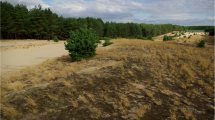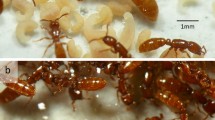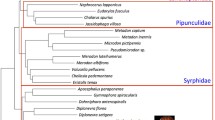Summary
Pogonomyrmex colei is a workerless inquiline ant known only from nests ofP. rugosus, its closest relative. Ten of 776 (1.3%) host nests were parasitized at a site in central Arizona, while none of 1499 potential host colonies were parasitized at two other locales. Colonies ofP. colei are perennial, and host alate females in 9 of 10 colonies demonstrates that host queens survive parasitism. Three of 10 colonies died over 19 colony years of observation, while only 1 of 601 colonies became newly parasitized. Mating occurs in morning for up to 2–3 days following summer and fall rains and in afternoon during cool fall days. Mating is intranidal just outside the nest entrance, with males returning to the natal nest. MaleP. colei may be flightless because their wing area is reduced compared to host males. Females fly from the nest and locate potential host colonies by following trunk trails. Workers are the largest barrier to nest establishment, as they removed over 90% ofP. colei females placed in trunk trails or that entered host nests. Males and females ofP. colei andP. anergismus, the only other congeneric inquiline species, are diminutive compared to their hosts, with females 30% lighter than host workers. Fat content is lower and water content is higher inP. colei andP. anergismus females than in their hosts.
Similar content being viewed by others
References
Blum, M. S., J. C. Moser and A. D. Cordero, 1964. Chemical releasers of social behavior. II. Source and specificity of the odor trail substances in four attine genera (Hymenoptera: Formicidae).Psyche 71:1–7.
Bourke, A. F. G. and N. R. Franks, 1991. Alternative adaptations, sympatric speciation and the evolution of parasitic, inquiline ants.Biol. J. Linn. Soc. 43:l57-l78.
Buschinger, A., 1986. Evolution of social parasitism in ants.Trends Ecol. Evol. 1:155–160.
Hadley, N. F., 1994. Water relations of terrestrial arthropods. Academic Press, New York.
Hölldobler, B. and E. O. Wilson, 1990. The ants. Belknap Press, Cambridge, Massachusetts.
Hölldobler, B., 1976. The behavioral ecology of mating in harvester ants (Hymenoptera: Formicidae:Pogonomyrmex).Behav. Ecol. Sociobiol. 1:405–423.
Johnson, R. A., 1995. Distribution and natural history of the workeless inquiline antPogonomyrmex anergismus Cole (Hymenoptera: Formicidae).Psyche, 101:257–262.
Keller, L. and K. Passera, 1989. Size and fat content of gynes in relation to the mode of colony founding in ants (Hymenoptera: Formicidae).Oecologia 80:236–240.
MacKay, W. P., 1981. A comparison of the nest phenologies of three species ofPogonomyrmex harvester ants (Hymenoptera: Formicidae).Psyche 88:25–74.
MacKay, W. P. and S. Van Vactor, 1985. New host record for the social parasitePogonomyrmex anergismus (Hymenoptera: Formicidae).Proc. Entomol. Soc. Wash. 87:863.
Nonacs, P. and J. E. Tobin, 1992. Selfish larvae: development and the evolution of parasitic behavior in the Hymenoptera.Evolution 46:1605–1620.
Rissing, S. W., 1983. Natural history of the workerless inquiline antPogonomyrmex colei (Hymenoptera: Formicidae).Psyche 90:321–332.
Snelling, R. R., 1981. The taxonomy and distribution of some North AmericanPogonomyrmex and descriptions of two new species (Hymenoptera: Formicidae).Bull. S. Cal. Acad. Sci. 80:97–112.
Stuart, R. J., L. Grisham-Bisett and T. M. Alloway, 1993. Queen adoption in the polygynous and polydomous ant,Leptothorax curvispinosus.Behav. Ecol. 4:276–281.
Wilson, E. O., 1963. Social modifications related to rareness in ant species.Evolution 17:249–253.
Wilson, E. O., 1965. Trail sharing in ants.Psyche 72:2–7.
Author information
Authors and Affiliations
Rights and permissions
About this article
Cite this article
Johnson, R.A., Parker, J.D. & Rissing, S.W. Rediscovery of the workerless inquiline antPogonomyrmex colei and additional notes on natural history (Hymenoptera: Formicidae). Ins. Soc 43, 69–76 (1996). https://doi.org/10.1007/BF01253957
Received:
Revised:
Accepted:
Issue Date:
DOI: https://doi.org/10.1007/BF01253957




